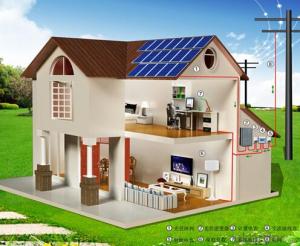CNBM SOLAR Roof Solar System 10000W Popular in Africa
- Loading Port:
- Shanghai
- Payment Terms:
- TT OR LC
- Min Order Qty:
- 1 PCS
- Supply Capability:
- 3000 PCS/month
OKorder Service Pledge
OKorder Financial Service
You Might Also Like
Introduction of Solar Home System
Solar arrays are designed to provide specified amounts of electricity under certain conditions. The following factors are usually considered when determining array energy performance:
Characterization of solar cell electrical performance
Determination of degradation factors related to array design and assembly
Conversion of environmental considerations into solar cell operating temperatures
Calculation of array power output capability.
The amount of electricity required may be defined by any one or a combination of the following performance criteria:
Power output -- power (Watts) available at the power regulator, specified either as peak power or average power produced during one day.
Energy output -- the amount of energy (Watt-hour or Wh) produced during a certain period of time. The parameters are output per unit of array area (Wh/m²), output per unit of array mass (Wh/kg), and output per unit of array cost (Wh/$).
Conversion efficiency -- defined as "energy output from array" ÷ "energy input from sun" × 100%.
This last parameter is often given as a power efficiency, equal to "power output from array" ÷ "power input from sun" × 100%. Power is typically given in units of Watts (W), and energy is typically in units of Wh, or the power in Watts supplied during an hour.
To ensure the consistency and quality of PV systems and increase consumer confidence in system performance, various groups -- such as the Institute of Electrical and Electronics Engineers (IEEE), the International Electrotechnical Commission (IEC), and the American Society for Testing and Materials (ASTM) -- are working on standards and performance criteria for PV systems.
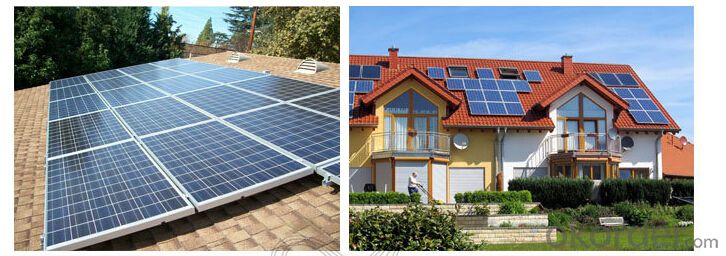


Working Principle of Solar Roof System
The stand alone Solar Home System is an off-grid solar system which uses batteries to store the solar energy. Stand alone solar system solutions design for those who are not able or willing to connect to electricity grid.
Specification of Solar Home System
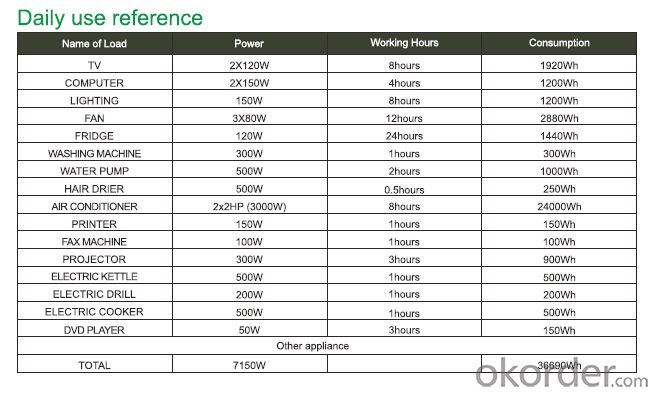
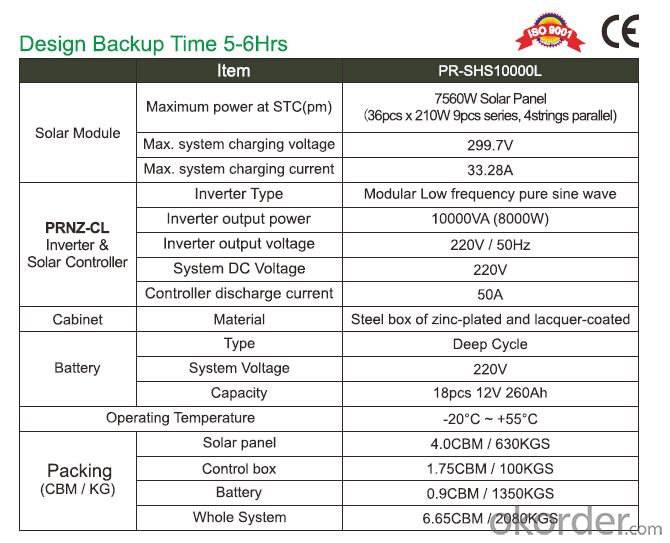
Product Features of Solar Home System
1. Off grid solar power system is mainly used for application with relatively-small power consumption, and the areas have no grid network coverage, or grid power is unstable or outage condition.
2. It’s composed of solar panels, hybrid solar inverter, battery bank, solar panel mounting racks, and other accessories required fora complete home solar power system.
3. The battery bank gives a stable power output to the solar inverter which converts DC to AC to power loads, and provides power backup in rainy or cloudy days.
4. The solar panels generate electricity at daytime and charge the battery bank.
5. The off grid home solar power system provides grid power bypass in case of battery power shortage when sunshine is not enough.
6. All the off grid home solar power system configurations are worked out by scientific calculation and design.
Advantage of Our Solar Home System
1 Excellent Performance: Our Solar Home System is composed by Brand Standard Kits with high quality. Our solar system has the advantage of high efficiency and stable operation. We can ensure our product with a long life period.
2. Small Orders Accepted: We can accept small orders as our customer’s trial order.
3. Warehouse: We have warehouse overseas which can bring great convenience to our customer to pick up the products.
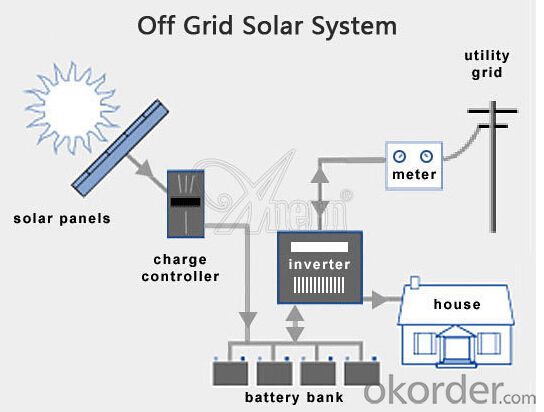
Terms and Conditions
1. Trade terms: FOB Shanghai
2. Payment terms: 30% T/T, balanced before shipment/ LC at sight before shipment. Actual Terms can be negotiated for big order.
3. Package: Exported standard package suitable for tough handling and sea transport.
4. Delivery: Goods to be ready within 10~30 days depending on order quantity.
5. Warranty: 10 years for solar panel, 2 years for controller/inverter/battery.
FAQ
Q: Could you introduce the background of your company?
A: We are a Group corp. with 1GW capacity in China, which is Okorder’s registered VIP Supplier, possess Financial Service from Okorder.com.
Q: Required mainly certificates (CE&IEC/TUV/RoHS)?
A: Our products are certificated by CE RoHS, IEC, ISO, TUV, UL etc.
Q: Your main exported market is?
A: Main markets of our products is: South-east Asia, Mid-east, Arica, East Europe and Latin America.
- Q:Is A grade better than the B grade when we buy the poly solar cells.
- The poly solar cell with A grade means the sustainabilty and quality of the poly solar cells are better than the others.
- Q:Are there any subsidies or incentives for installing solar cells?
- Yes, there are various subsidies and incentives available for installing solar cells. These can include federal tax credits, state and local incentives, grants, and rebates. These measures aim to promote the adoption of solar energy and make it more affordable for individuals and businesses to invest in solar panel installations.
- Q:What is the effect of wind on solar cell performance?
- The effect of wind on solar cell performance can be both positive and negative. On one hand, a gentle breeze can help to cool down the solar panels, preventing them from overheating and improving their overall efficiency. On the other hand, strong winds can create vibrations that may lead to structural damage or reduce the stability of the solar panels, potentially affecting their performance. Therefore, it is important to strike a balance between the benefits of cooling and the risks associated with excessive wind exposure when designing and installing solar systems.
- Q:What is the impact of saltwater exposure on solar cell efficiency?
- Saltwater exposure can have a significant negative impact on solar cell efficiency. The saltwater can corrode the metal components of the solar cells, leading to a decrease in their performance and overall efficiency. Additionally, the saltwater can create a conductive pathway that can bypass the solar cells, resulting in a loss of electrical energy. Therefore, it is crucial to protect solar cells from saltwater exposure to maintain their efficiency and prolong their lifespan.
- Q:Can solar cells store energy for later use?
- No, solar cells cannot store energy for later use. They convert sunlight directly into electricity in real-time and do not have the capability to store the generated energy.
- Q:Where can I get a competitive price for this solar cell? The 2bb/3bb polycrystalline solar cell panel?
- We are a solar cell company based in Shandong, and we sell 2BB/3BB Polycrystalline solar cells/multi-solar cells.
- Q:Can solar cells be used to power water treatment plants?
- Yes, solar cells can be used to power water treatment plants. Solar energy can be harnessed to generate electricity, which can then be used to power the various processes involved in water treatment, such as pumping, filtration, and disinfection. Solar-powered water treatment plants are an environmentally friendly and sustainable solution, especially in remote areas where access to grid electricity may be limited.
- Q:Can solar cells be used in areas with high pollution?
- Yes, solar cells can be used in areas with high pollution. While pollution can reduce the efficiency of solar cells, they can still generate electricity in such areas. However, regular cleaning and maintenance may be required to ensure optimal performance.
- Q:Why are the poly Solar cell specifications is different from each other, they seem to have the different size of 125mm, 156mm, 152mm, is the 152mm's battery technology is higher than the other?
- We seldom see poly solar cell with the size of 152, because that is not really good to use.
- Q:How do solar cells perform in areas with high levels of light pollution?
- Solar cells perform less efficiently in areas with high levels of light pollution. Light pollution not only reduces the amount of natural sunlight reaching the solar cells but also introduces artificial light sources that can interfere with the cell's ability to absorb and convert sunlight into electricity. As a result, the overall performance and energy output of solar cells are compromised in such areas.
1. Manufacturer Overview |
|
|---|---|
| Location | |
| Year Established | |
| Annual Output Value | |
| Main Markets | |
| Company Certifications | |
2. Manufacturer Certificates |
|
|---|---|
| a) Certification Name | |
| Range | |
| Reference | |
| Validity Period | |
3. Manufacturer Capability |
|
|---|---|
| a)Trade Capacity | |
| Nearest Port | |
| Export Percentage | |
| No.of Employees in Trade Department | |
| Language Spoken: | |
| b)Factory Information | |
| Factory Size: | |
| No. of Production Lines | |
| Contract Manufacturing | |
| Product Price Range | |
Send your message to us
CNBM SOLAR Roof Solar System 10000W Popular in Africa
- Loading Port:
- Shanghai
- Payment Terms:
- TT OR LC
- Min Order Qty:
- 1 PCS
- Supply Capability:
- 3000 PCS/month
OKorder Service Pledge
OKorder Financial Service
Similar products
New products
Hot products
Related keywords
